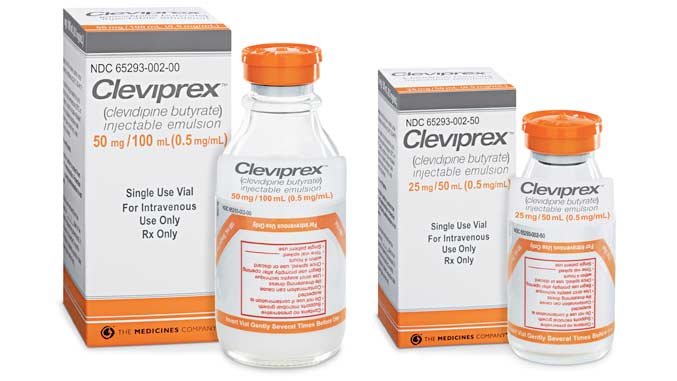制造商:
中药公司
药理分类:
钙通道阻滞剂(二氢吡啶)
活性成分(补):
丁酸氯维地平乳剂为0.5mg/ml;为静脉注射溶液,含有脂质0.2g/mL(大豆油,鸡蛋磷脂)。
指示(补):
为了降低血压当口服治疗不可行或不可取。
药理作用:
氯维地平是一种钙通道阻滞剂的药物用于静脉infusion.Other油包水乳剂,制定本类包括氨氯地平,非洛地平,硝苯地平,并nisoldipine.In体内研究表明,这种药物可以减少平均动脉血管阻力降低血压。它不影响心脏充盈压(预载)。
临床试验:
两个双盲,随机,安慰剂对照研究,进行冠状动脉搭桥术的病人。一项研究包括与平均血压的178/77mmHg,及其他包括后运与患者的平均血压的七十一分之一百五十〇前运病人。在两项研究中,血压降低2-4内启动cleviprex输液分钟。
法律分类:
接收
成人:
≥18yrs:个体化;由四infusion.Initially 1-2mg/hr titrate.Give;在接近目标之前,英国石油公司90秒的时间间隔剂量加倍,然后滴定速度较慢(调整为5 - 10分钟的间隔)1 - 2毫克剂量的增加/。人力资源结果收缩压约2 - 4mmHg.Maintenance降低:4-6mg/hr;一般不超过最大16-32mg/hr.Do(为24小时21mg/hr)1000毫升,由于脂质load.Switch口服治疗时表示。
儿童:
≤18yrs:不推荐。
禁忌(补):
鸡蛋或大豆过敏。脂质代谢缺陷(例如,病理性高脂血症,脂质肾病,高脂血症急性胰腺炎)。严重的动脉狭窄。
警告/注意事项:
监测血压和脉搏输液过程中,直到stabilized.Heart故障(显示器)。Pheochromocytoma.Monitor高血压的反弹,至少8小时后停止输液(如果不是长时间输液后给予其他降血压药物)。劳动和delivery.Pregnancy(Cat.C) 。护理母亲。
不良反应(补):
头痛,恶心,呕吐,低血压,反射性心动过速(慢输液如果发生,不使用β-阻断剂),稀有:心肌梗死,心脏骤停,晕厥,呼吸困难。
如何提供:
一次性使用瓶,50毫升,100毫升
Cleviprex(丁酸氯维地平注射乳剂)获得FDA批准上市
Medicines公司近日宣布美国FDA已接受了Cleviprex(丁酸氯维地平注射乳剂, clevidipine butyrate)的上市申请,该药申请用于治疗急性高血压。如果Cleviprex能获得批准将成为10多年来批准用于治疗急性高血压的又一个新药。
公司官员说道:“对于数以百万计的经历过高血压紧急情况患者、手术中或手术后出现高血压紧急情况的患者,快速与准确的血压控制能改善患者的预后。在全面的临床试验中,Cleviprex能提供快速的,可预知的血压可逆性控制。这种独特的特点将能给医院患者的血压控制提供一种重要选择,而没有现在已有药物的诸多限制。我们开发该药就是为了特别迎合医生在医院处置中的需要。如果能获得批准该药有望于2008年中期正式上市。我们希望该药能成为公司在美国市场的一个重要增长点。”
Cleviprex为一种创新的注射型抗高血压药物,用于治疗急性高血压,效果可持续72小时,该药可在口服药物无效或患者不方便使用口服药物时使用,其起效迅速。与现有高血压药物通过肾或肝脏代谢不同,Cleviprex在血液中代谢,不会在体内积蓄,特别适用于哪能些晚期器官损害的患者。
About Cleviprex®Cleviprex (clevidipine butyrate) injectable emulsion
Cleviprex is the latest-generation intravenous (IV) dihydropyridine calcium channel blocker, and is indicated for the reduction of blood pressure (BP) when oral therapy is not feasible or not desirable. With its rapid onset and offset of effect and ultrashort half-life, Cleviprex can be titrated for predictable BP control. Unlike many current antihypertensive treatments that are metabolized by the kidney or liver,Cleviprex is metabolized by esterases in the blood and extravascular tissues1 and does not accumulate in the body.
IMPORTANT SAFETY INFORMATION
Cleviprex is intended for intravenous use. Titrate drug depending on the response of the individual patient to achieve the desired blood pressure reduction. Monitor blood pressure and heart rate continually during infusion, and then until vital signs are stable. Patients who receive prolonged Cleviprex infusions and are not transitioned to other antihypertensive therapies should be monitored for the possibility of rebound hypertension for at least 8 hours after the infusion is stopped.
Cleviprex is contraindicated in patients with allergies to soybeans, soy products, eggs, or egg products; defective lipid metabolism such as pathologic hyperlipemia, lipoid nephrosis, or acute pancreatitis if it is accompanied by hyperlipidemia; and in patients with severe aortic stenosis.
Hypotension and reflex tachycardia are potential consequences of rapid upward titration of Cleviprex. Dihydropyridine calcium channel blockers can produce negative inotropic effects and exacerbate heart failure. Monitor heart failure patients carefully. Cleviprex gives no protection against the effects of abrupt beta-blocker withdrawal.
Most common adverse reactions (> 2%) are headache, nausea, and vomiting.
Cleviprex should be used during pregnancy only if the potential benefit justifies the potential risk to the fetus.
Maintain aseptic technique while handling Cleviprex. Cleviprex contains phospholipids and can support microbial growth. Do not use if contamination is suspected. Once the stopper is punctured, use and discard within 4 hours.
Cleviprex side effects
Get emergency medical help if you have any of these signs of an allergic reaction: hives; difficulty breathing; swelling of your face, lips, tongue, or throat. Call your doctor at once if you have a serious side effect such as:
feeling like you might pass out;slow heart rate;urinating less than usual or not at all;
drowsiness, confusion, mood changes, increased thirst, loss of appetite, vomiting;
feeling short of breath, even with mild exertion;swelling, rapid weight gain; or chest pain or heavy feeling, pain spreading to the arm or shoulder, nausea, sweating, general ill feeling.
Less serious Cleviprex side effects may include:headache; ormild nausea.
This is not a complete list of side effects and others may occur. Tell your doctor about any unusual or bothersome side effect. You may report side effects to FDA at 1-800-FDA-1088.
CLEVIPREX
Manufacturer:
The Medicines Company
Pharmacological Class:
Calcium channel blocker (dihydropyridine)
Active Ingredient(s):
Clevidipine butyrate emulsion 0.5mg/mL; soln for IV infusion; contains lipids 0.2g/mL (soybean oil, egg phospholipids).
Indication(s):
To reduce blood pressure when oral therapy is not feasible or desirable.
Pharmacology:
Clevidipine is a calcium channel blocker formulated in an oil-in-water emulsion for IV infusion.Other drugs in this class include amlodipine, felodipine, nifedipine, and nisoldipine.In vivo studies indicate that this drug reduces mean arterial blood pressure by reducing vascular resistance.It does not affect cardiac filling pressure (pre-load).
Clinical Trials:
Two double-blind, randomized, placebo-controlled studies were conducted with patients undergoing coronary artery bypass grafting. One study included pre-op patients with mean BP of 178/77mmHg, and the other included post-op patients with a mean BP of 150/71. In both studies, BP was lowered within 2–4 minutes of starting the cleviprex infusion.
Legal Classification:
Rx
Adults:
≥18yrs: Individualize; titrate.Give by IV infusion.Initially 1–2mg/hr; double dose at 90-second intervals until BP approaches goal, then titrate slower (adjust at 5–10minute intervals).Dose increases of 1–2mg/hr results in systolic BP lowering of about 2–4mmHg.Maintenance: 4–6mg/hr; usual max 16–32mg/hr.Do not exceed 1000mL (21mg/hr for 24hrs) due to lipid load.Switch to oral therapy when indicated.
Children:
≤18yrs: not recommended.
Contraindication(s):
Egg or soy allergy. Defective lipid metabolism (eg, pathologic hyperlipemia, lipoid nephrosis, acute pancreatitis with hyperlipidemia). Severe artery stenosis.
Warnings/Precautions:
Monitor BP and pulse during infusion and until stabilized.Heart failure (monitor).Pheochromocytoma.Monitor for rebound hypertension for at least 8hrs after stopping infusion (if not given other antihypertensives after prolonged infusion).Labor & delivery.Pregnancy (Cat.C).Nursing mothers.
Adverse Reaction(s):
Headache, nausea, vomiting; hypotension, reflex tachycardia (slow infusion if occurs, do not use beta-blocker); rare: myocardial infarction, cardiac arrest, syncope, dyspnea.
How Supplied:
Single-use vials—50mL, 100mL
Last Updated:
1/14/2009


